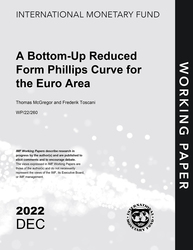
A Bottom-Up Reduced Form Phillips Curve for the Euro Area
A Bottom-Up Reduced Form Phillips Curve for the Euro Area
READ MORE...
Volume/Issue:
Volume 2022
Issue 260
Publication date: December 2022
ISBN: 9798400219108
$20.00
Add to Cart by clicking price of the language and format you'd like to purchase
Available Languages and Formats
| English |
Prices in red indicate formats that are not yet available but are forthcoming.
Topics covered in this book
This title contains information about the following subjects.
Click on a subject if you would like to see other titles with the same subjects.
Inflation , Economics- Macroeconomics , Economics / General , Industries - Energy , Euro area , Inflation , Phillips curve , inflation expectation , inflation pressure , augmented Phillips curves , forecast accuracy , drivers of inflation , Natural gas sector , Fuel prices , Oil prices , Food prices , Global
Summary
We develop a bottom-up model of inflation in the euro area based on a set of augmented Phillips curves for seven sub-components of core inflation, and auxiliary regressions for non-core items. The disaggregated structure of the model improves on the forecasting performance of a standard one-equation Phillips curve, especially since the onset of the Covid-19 pandemic in early-2020 and the following energy shocks. We find a key role for international energy and food prices in explaining the recent surge in inflation – as of Q2 2022, they account for 75 percent of the increase in headline inflation and 30 percent of the increase in core. Economic slack and inflation expectations explain another 10 percent of headline and 20 percent of core inflation. Around one-third of the increase in core inflation remains unexplained by the model. Out of sample projections show high uncertainty around the inflation path while suggesting that inflation pressures are unlikely to dissipate quickly. We argue that the bottom-up approach offers a useful complement to the forecaster’s toolbox–especially in the current environment of sectoral shocks - by improving forecast accuracy, shedding additional light on the drivers of inflation, and providing a framework in which to apply ex-post judgement in a structured way.
Copyright © 2010 - 2025
Powered by:
AIDC



